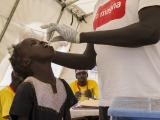Many US foodborne illness outbreaks are caused by contamination of food from an animal or environmental source before final preparation, with most viral outbreaks triggered by infected food workers, and foods left out for a prolonged period plus inadequate time and temperature control during cooking contribute to bacterial outbreaks, according to new data from Foodborne Disease Outbreak Surveillance System (FDOSS).
The report was published today in Morbidity and Mortality Weekly Report.
800 outbreaks, 15,000 illnesses a year
Researchers with the CDC and public health departments analyzed FDOSS data via the CDC's National Outbreak Reporting System on foodborne illness outbreaks from 2014 to 2022 and reported by state and local health departments. Outbreaks are defined as two or more cases with a shared source.
About 800 such outbreaks are reported in the United States each year, leading to about 15,000 illnesses, 800 hospitalizations, and 20 deaths.
"Contributing factors are food preparation practices, behaviors, and environmental conditions that lead to pathogens getting into food, growing in food, or surviving in food and are grouped into three categories: contamination (when pathogens and other hazards get into food), proliferation (when pathogens that are already present in food grow), and survival (when pathogens survive a process intended to kill or reduce them," the study authors wrote.
Contamination by infected food workers fell over time
A total of 6,618 foodborne illnesses were reported from 2014 to 2022. The study encompassed 2,677 such outbreaks that listed contributing factors and categorized them into three periods: 2014 to 2016 (first), 2017 to 2019 (second), and 2020 to 2022 (third).
Of the 2,677 outbreaks, 42.7% occurred during the first period, 42.2% were reported during the second period, and 15.1% took place during the third. The proportion linked to food prepared at restaurants increased from the first to the second period but decreased slightly in the third (57.6%, 63.2%, and 58.8%, respectively).
The proportion of outbreaks associated with institutional or commercial food preparation declined from the first to the second period before rising in the third (institutional preparation, 6.4%, 5.3%, and 9.6%, respectively; commercial preparation, 9.1%, 7.4%, and 10.6%, respectively).
The percentage of bacterial outbreaks rose from the first (41.9%) to the third (48.4%) period, while the percentage of viral outbreaks fell from 33.3% to 23.2%.
The proportion of bacterial outbreaks involving an aquatic animal source climbed from the first (12.0%) to the second period (18.5%), then stayed about the same in the third (18.3%). The percentage of outbreaks with a land animal source decreased from the first (16.7%) to the second period (14.2%) and then increased in the third (15.1%).
Among bacterial outbreaks tied to contamination, the percentage of food tainted by an animal or environmental source before final preparation rose over the three periods, from 22.2% to 27.7% to 32.3%. And the proportion listing contamination from an infected food worker through ungloved contact with food dropped over time, from 20.5% to 15.2% to 8.9%.
17% of outbreaks traced to homemade food
The proportion of outbreaks with a proliferation factor linked to unsafe temperature deviations from leaving food out for a prolonged time during preparation and food service or display declined over the three periods (preparation, 15.2%, 12.2%, and 9.9%, respectively; and food service or display, 13.6%, 10.4%, and 8.9%, respectively).
Roughly 16.5% of outbreaks during each period were traced to food made in private homes, including those taken to events such as picnics, potlucks, and celebrations.
The percentage of improper cooling of food decreased from the first (9.4%) to the second period (8.8%) and then climbed during the third (10.9%). For the survival category—when pathogens survive a process, such as heating, intended to kill them—the proportion of outbreaks tied to inadequate time and temperature control during initial cooking dropped from the first (12.1%) to the second period (9.6%) and then rebounded during the third (12.1%).
Among outbreaks with a bacterial source, cross-contamination of foods was in the top five contributing factors during the first (22.0%) and second periods (20.8%) but not during the third, while inadequate time and temperature control during initial cooking was in the top five during all three periods (23.8%, 20.4% and 20.9%, respectively). Improper cooling was among the top five only during the third period, at 17.3%.
Of viral outbreaks, contamination from an infected food worker through ungloved contact with food was one of the two most common contributing factors in the first (47.1%) and second periods (37.7%), falling to the third most common factor during the third period (28.7%). Infected workers who wore gloves when handling food were among the top five factors in the first (32.1%) and second period (25.5%) and the most common factor in the third (42.5%).
Roughly 16.5% of outbreaks during each period were traced to food made in private homes, including those taken to events such as picnics, potlucks, and celebrations.
Pandemic may have driven down viral outbreaks
The researchers said the decline in the proportion of viral outbreaks and those associated with contamination from 2020 to 2022 could be attributed to effects of the COVID-19 pandemic.
Restaurant managers can mitigate contamination by ill food workers by implementing written policies concerning ill worker management, developing contingency plans for staffing during worker exclusions, and addressing reasons why employees work while sick.
"Nonpharmaceutical interventions (e.g., increased glove use, cleaning and disinfection, and closure of restaurant dining areas) implemented during the COVID-19 pandemic likely led to a reduction in norovirus, which is typically spread by infectious food workers," they wrote.
Retail food outlets should adhere to evidence-based food safety guidelines such as the Food and Drug Administration Food Code and Hazard Analysis and Critical Control Points (HACCP) plans, the authors said.
"Restaurant managers can mitigate contamination by ill food workers by implementing written policies concerning ill worker management, developing contingency plans for staffing during worker exclusions, and addressing reasons why employees work while sick," they wrote. "Health department staff members who investigate outbreaks and conduct routine inspections can encourage restaurants to follow their HACCP plans and other verified food safety practices, such as cooling, to prevent outbreaks."



















